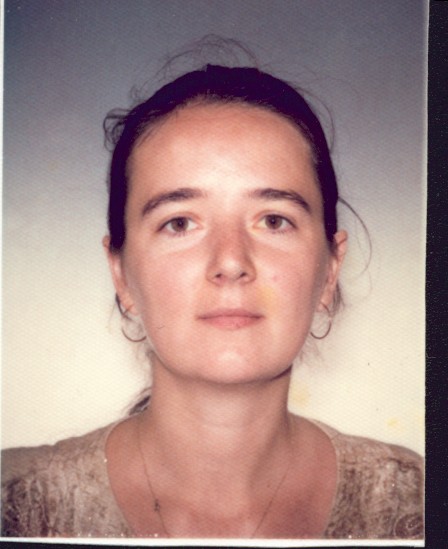

INSTITUTE OF ATOMIC PHYSICS
NATIONAL INSTITUTE FOR LASERS, PLASMA AND RADIATION PHYSICS
LASERS DEPARTMENT
ATOMISTILOR 111, 76900 BUCHAREST – MAGURELE, ROMANIA
Tel:0040-21-457 44 91, 457 45 50 ext. 1815
Fax: 0040-21-457 42 43, 457 44 67
E-mail: eniko.gyorgy@inflpr.ro
| Senior Research Scientist 1st degree |
2006 to date
|
Main Fields of Interest
-Laser-surface-plasma interactions, surface physics
-3D structures formation on metal or semiconductor surfaces as an effect of multipulse laser irradiation in vacuum, or reactive atmospheres (O2, N2, NH3)
-Pulsed laser deposition (PLD) and reactive pulsed laser deposition (RPLD) of thin films
-Studied materials: Ti, Si, Ta, TiC, Si3N4, SiC, CNx, CWx, biomaterials HA (Ca10(PO4)6(OH)2), TiN, TiO2, AlN, SrFe12O19, TaOx, YBa2Cu3O7-x
-Laser direct synthesis of compound layers on metallic surfaces irradiated in controlled reactive atmospheres
-Surface characterisation techniques: electron spectroscopy (XPS, AES), Raman spectroscopy, spectrophotometry, electron microscopy, X ray diffraction (XRD), nuclear techniques (RBS, ERDA), secondary ion mass spectrometry (SIMS)
|
B.Sc in Physics |
Faculty of Physics, University of Bucharest, Romania |
1989-1994 |
|
Master in Physics |
Faculty of Physics, University of Bucharest, Romania |
1994-1995 |
Doctorate
|
Ph.D in Physics |
Institute of Atomic Physics, Bucharest, Romania |
1995-1998 |
|
|
Institution |
|
|
Research Assistant |
Institute of Atomic Physics, Bucharest, Romania |
1994-1995 |
|
Scientific Researcher |
Institute of Atomic Physics, Bucharest, Romania |
1996 - present |
|
Lecturer |
Faculty of Physics, University of Bucharest, Romania Lectures and seminars for the 5th year students on “Laser-Material Interactions” |
1999 - present |
|
|
Speak |
Read |
Write |
|
Hungarian |
C |
C |
C |
|
Romanian |
C |
C |
C |
|
English |
C |
C |
C |
|
German |
R |
C |
C |
|
Italian |
R |
G |
G |
|
Spanish |
G |
C |
C |
|
|
|
|
1. |
University of Lecce, Italy, Physics Department 02.03.1996-15.03.1996 |
|
2. |
International Center for Theoretical Physics (ICTP), Workshop “Synthesis and Characterisation of Thin Films” 16.03.1996-15.04.1996 |
|
3. |
“Johannes Kepler” University Linz, Austria, Physics Department 23.04.1997-24.06.1997 |
|
4. |
Foundation for Reserach and Technology of Hellas, Institute of Electronic Structures and Lasers FORTH-IESL, Heraklion, Greece 03.05.1998-03.06.1998 |
|
5. |
University of Lecce, Italy, Physics Department 20.08.1998-06.12.1998 |
|
6. |
University of Milano, Italy, Physics Department 07.12.1998-22.12.1998 |
|
7. |
Foundation for Reserach and Technology of Hellas, Institute of Electronic Structures and Lasers FORTH-IESL, Heraklion, Greece 02.06.1999-01.07.1999 |
|
8. |
The National Hellenic Research Foundation, Institute of Theoretical Physics and Chemistry, Athens 02.07.1999-16.07.1999 |
|
9. |
Institute of Electronics, Sofia 21.10.1999-31.10.1999 |
|
10. |
Institute of Physics, Prague 01.11.1999-08.11.1999 |
|
11. |
”Jozsef Attila University, Szeged, Hungary 09.11.1999-23.11.1999 |
|
12. |
University of Barcelona, Department of Applied Physics and Optics 04.03.2000-08.09.2003 |
|
13. |
Institute of Materials Science of Barcelona, CSIS, Spain 15.06.2004-09.09.2004 |
|
14. |
The National Hellenic Research Foundation, Institute of Theoretical Physics and Chemistry, Athens 10.09.2004-18.09.2004 |
|
15. |
Institute of Materials Science of Barcelona, CSIS, Spain 15.01.2005-22.03.2005 |
i. Parametric study of TiN thin films obtained by reactive laser ablation of titanium targets in nitrogen atmosphere: the role of the ambient gas pressure and of the oxyge contamination.
ii. Study of the crater formed on the surface of Ti targets under laser irradiation in nitrogen atmosphere.
iii. Synthesis and deposition of thin films of titanium carbide by reactive laser ablation of titanium targets in methane atmosphere: study of the chemical composition.
iv. Deposition of silicon carbide thin films by reactive laser ablation of silicon targets in methane atmosphere.
v. Morphology of tungsten carbide thin films obtained by laser ablation of tungsten targets in methane atmosphere.
vi Crystalline structure of tungsten carbide thin films.
vi. Synthesis and deposition of silicon nitride thin films by reactive laser ablation of silicon: parametric study.
viii. Characterisation of carbon nitride thin films deposited by laser ablation of graphite targets in nitrogen atmosphere: morphology, chemical composition, crystalline state, optical and mechanical properties.
ix. Study of optical properties of carbon nitride thin films deposited by reactive laser ablation of graphite targets in NH3 at low pressure.
x. Elucidation of participation in chemical synthesis of the three main stages of the pulsed laser deposition process:
-substance expulsion from the target surface under the action of high intensity laser radiation
-transit through gas of the expulsed substance
-final impact of ablated substance onto the collector surface
xi. Elimination of particulates of different types and dimensions covering the surface of thin films deposited by reactive laser ablation, through IR laser irradiation of the plasma generated by the UV laser.
xii. Description of thermo-physical regimes on the target taking place as an effect of high intensity laser irradiation leading to the expulsion of substance in form of vapour and/or liquid.
xiii. Deposition and characterisation of AlN thin films obtained by fs- and ns-PLD: comparative study.
xiv. Direct laser synthesis of nitrides and oxides on the surface of Ti targets irradiated by a high repetition rate Nd:YAG laser, in chemically active atmosphere.
xv. Laser micro-processing of metallic surfaces in vacuum, Ar, or chemically active atmosphere.
xvi.Growth of undoped and noble metal doped semiconductor transition metal oxide thin films by laser ablation from metallic or oxide targets in oxygen atmosphere. Characterisation of surface morphology, chemical composition, crystalline state, optical and electrical properties.